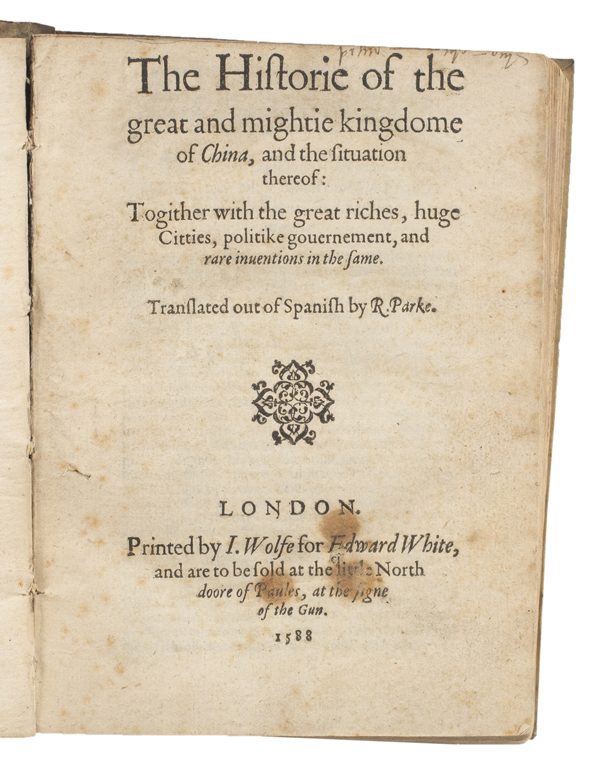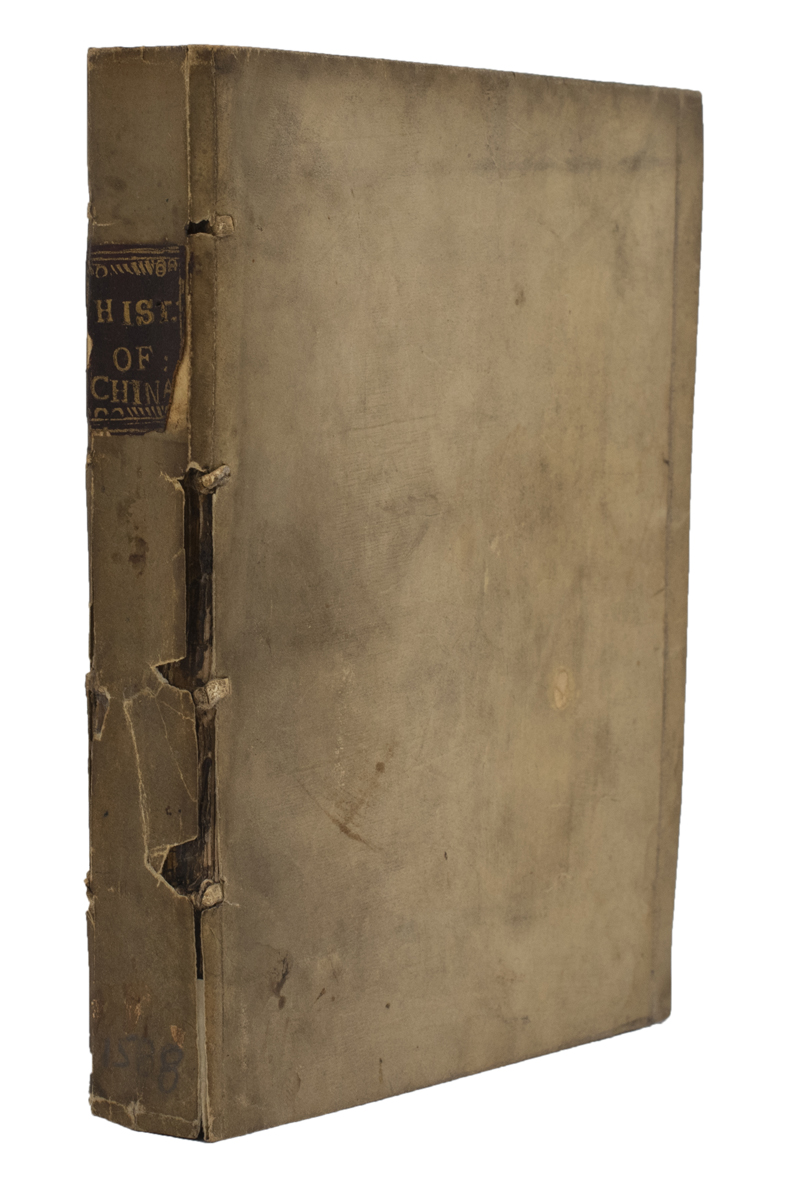

GONZALES DE MENDOZA, Juan.
The Historie of the Great and Mighty Kingdome of China, and the Situation thereof: together with the great Riches, huge Citties, politike Governement, and rare Inventions in the same. Translated out of Spanish by R. Parke.
London, Printed by J. Wolfe for Edward White, 1588[/9].
4to, pp. [8], 410, wanting the terminal blank; with three woodcuts of Chinese characters on pp. 92-3; three small wax stains (and one small hole) to title-page, small puncture to inner margin of first few gatherings, a little spotting and toning, withal an excellent copy in early limp vellum, yapp edges, morocco spine label; early purchase inscription to head of title (cropped), armorial bookplate of William Charles De Meuron Wentworth-Fitzwilliam, seventh Earl Fitzwilliam, numerous earlier shelfmarks.

Added to your basket:
The Historie of the Great and Mighty Kingdome of China, and the Situation thereof: together with the great Riches, huge Citties, politike Governement, and rare Inventions in the same. Translated out of Spanish by R. Parke.
First edition in English, rare, of the first significant European study of China, ‘one of the outstanding “best-sellers” of the sixteenth century’ (Boxer). A publication of enormous influence on Elizabethan conceptions of China, it also contained much information on the Spanish Americas. The translation, by Robert Parke, was undertaken at the request and encouragement of Richard Hakluyt, appearing before the latter’s Principal Navigations and was dedicated to the explorer Thomas Cavendish. The publisher John Wolfe had issued an edition in Italian under a false ‘Venice’ imprint in 1587, but this was the first time the work was accessible to a wider English audience.
Mendoza had departed on a mission to China in 1580, but because of political instability in the Philippines he made it no further then Mexico, returning to Spain and then Rome in 1583, where he was commissioned to write this history, drawing upon information provided by missionaries in Mexico. La Historia de las Cosas más Notables, Ritos y Costumbres del Gran Reyno de China was first published in Rome in 1585 and then in an expanded edition in Madrid in 1586, which added the report by Antonio de Espejo of his 1583 expedition to New Mexico (pp. 323–40 here). When the latter was translated here, it was among the earliest accounts of Mexico and New Mexico to appear in English.
The first part contains an account of the fifteen provinces of China and includes descriptions of printing, fishing, artillery, marriage customs and criminals. The second part is devoted to three expeditions: that of Martin de Rada, or de Harrada, to the Philippines in 1575, Pedro de Alfaro's journey in 1578, and that of Martin Ignacio de Loyola in 1581. The latter, which includes also the section derived from Espejo, describes Mexico, Cuba, Puerto Rica, Jamaica, Santo Domingo and the Canaries, and was a major source for Ortelius in compiling his atlas.
The publication of the Historia ‘may be taken to mark the date from which an adequate knowledge of China and its institutions was available for the learned world of Europe” (Hudson, p. 242). ‘Mendoza’s clarity, his penetrating insights, and his lively style must also have contributed to its popularity. In fact, the authority of Mendoza’s book was so great that it became the point of departure and the basis of comparison for all subsequent European works on China written before the eighteenth century’ (Lach I.ii. p. 744). ‘It is probably no exaggeration to say that Mendoza’s book had been read by the majority of well-educated Europeans at the beginning of the seventeenth-century. Its influence was naturally enormous, and it is not surprising to find that men like Francis Bacon and Sir Walter Raleigh derived their notions of China and the Chinese primarily, if not exclusively, from this work. Even travellers who, like Jan Huighen van Linschoten, had themselves been in Asia, relied mainly on Mendoza’s Historia for their accounts of China …” (Boxer).
STC 12003; Alden 588/39; Church 134; Palau 105513; Cordier, Sinica 13; Sabin 27783 (‘It is so rare that we have never seen it’).